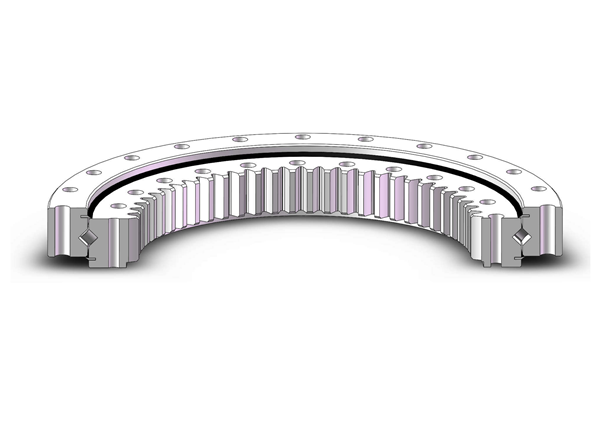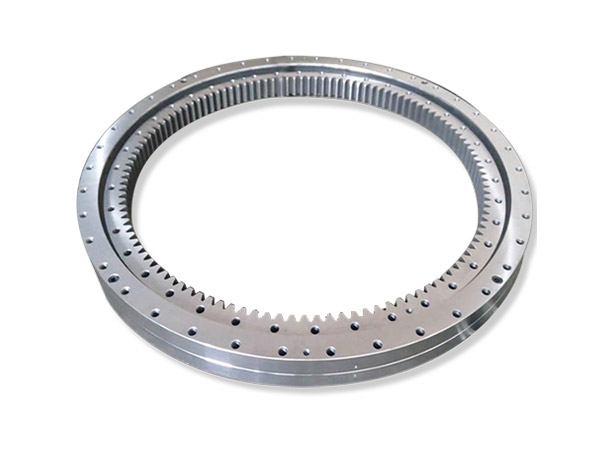How many degrees can the slewing bearing temperature generally not exceed? Solutions for overheating
The temperature of the slewing bearing directly reflects whether the bearing is running normally. If the bearing temperature is too high, it may directly reflect that there may be some kind of failure in the bearing, which directly affects the performance of the machine. So how many degrees can the slewing bearing temperature generally not exceed?
Under normal circumstances, the temperature of the slewing bearing should not exceed 70℃, because the allowable temperature of the lubricating grease of the slewing bearing should be less than 80℃. Let’s take a look at the normal temperature range of the slewing bearing and how to solve the problem if the temperature is too high.

1. The normal range of slewing bearing temperature
The temperature of the slewing bearing is mainly limited by the heat-resistant temperature of the bearing steel, cage, sealing material and lubricant, and in general, the working temperature of the slewing bearing should not be higher than 95 ℃. The aforementioned slewing bearing temperature should not exceed 70°C is calculated based on the grease life. If the operating temperature increases by 15°C, the grease life will be reduced by half. Among the heat-resistant temperature limits of several materials that affect the temperature of the slewing bearing, the heat-resistant temperature of the grease is lower, so this is the upper limit.
The normal working temperature that ordinary bearings can withstand is between 40 degrees Celsius and 70 degrees Celsius, but the ideal working temperature of slewing bearings should be in the range of 40-60 degrees Celsius. The slewing bearing used in the low temperature environment can be used in the vacuum environment. The selection of the low temperature bearing does not affect the working performance of the bearing, and it can also be used normally at minus 60 ℃.
Surface temperature of slewing bearing: When the bearing is running under the specified working conditions, the temperature of the outer surface of the built-in bearing should not be higher than the temperature of the conveying medium by 20℃, and the upper limit of the temperature should not be higher than 80℃. The temperature rise of the outer surface of the externally mounted bearing should not be higher than the ambient temperature by 40°C. The temperature is not higher than 80℃.
The ambient temperature of the turntable: the temperature rise of the bearing shall not exceed the ambient temperature of 35°C, and the upper limit of the temperature shall not exceed 75°C.
After understanding how many degrees the slewing bearing temperature cannot generally exceed, let’s take a look at how we can solve the problem when the slewing bearing temperature is too high.

2. The solution to the high temperature of the slewing bearing
A high temperature often indicates that the bearing is in an abnormal state. High temperatures are also detrimental to bearing lubricants. Sometimes bearing overheating can be attributed to the lubricant in the bearing. If the bearing is continuously rotated for a long time at a temperature exceeding 125°C, the service life of the bearing will be reduced. Factors that cause high temperature bearings include: lack of lubrication or too much lubrication, lubricants. There are impurities inside, the load is too large, the bearing ring is damaged, the clearance is insufficient, and the high friction caused by the oil seal, etc. The solution to the high temperature of the slewing bearing:
(1) Adjust the amount of grease injected
Too much or too little grease will lead to abnormal bearing temperature. Too little bearing grease will not be able to lubricate the bearing, which will cause internal wear of the bearing and cause temperature rise. At the same time, too much bearing grease will also cause abnormal heating of the bearing. Therefore, the injection amount of bearing grease should be adjusted.
(2) Replace the grease
The mixing of different types of grease may cause the grease to deteriorate and agglomerate, which will affect the lubrication effect and cause the bearing to heat up. If the grease is polluted by external dust, it may also destroy the bearing lubrication and cause the temperature to rise. The suitable bearing grease should be replaced in time. , and do a good job of bearing moisture-proof and dust-proof measures.
(3) Overhaul the cooling system
If the pipeline of the bearing is blocked, the oil inlet temperature and return water temperature exceed the standard, or the cooler is not suitable for the cooling effect, the bearing temperature will be too high. At this time, it should be replaced in time or a new cooler should be installed in parallel. The axial flow induced draft fan should also check the insulation and sealing of the core cylinder.
(4) Check the coupling
If none of the above problems exist, the coupling needs to be checked. The thermal expansion of the equipment during operation should also be considered when aligning the axial-flow induced draft fan and the hydraulic coupler. The impeller side of the induced draft fan expands due to heat, and the bearing box rises; during the operation of the hydraulic coupling, the temperature rises, the bearing box expands, and the bearing rises, so the motor should be higher when aligning, and the size of the reserved amount depends on the characteristics of the equipment and Depends on the operating temperature parameters.
The above is the reason why the bearing temperature is too high. By measuring the bearing temperature, it can also help us to find out the possible problems of the bearing in time. Therefore, it is necessary to continuously detect the bearing temperature, whether it is to measure the bearing itself or other key parts. If the operating conditions do not change, all temperature changes can indicate a failure.


